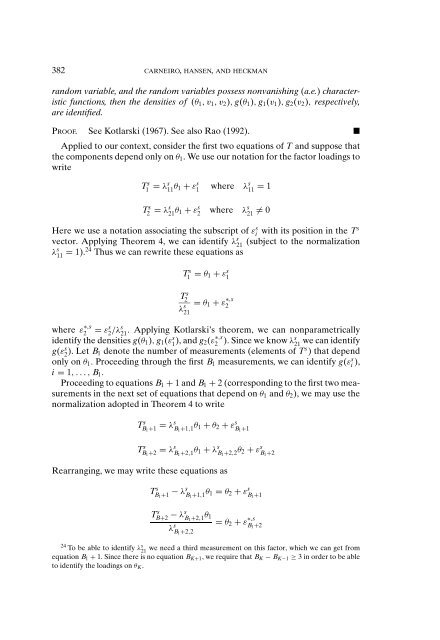Estimating Distributions of Counterfactuals with an Application ... - UCL
Estimating Distributions of Counterfactuals with an Application ... - UCL
Estimating Distributions of Counterfactuals with an Application ... - UCL
Create successful ePaper yourself
Turn your PDF publications into a flip-book with our unique Google optimized e-Paper software.
382 CARNEIRO, HANSEN, AND HECKMAN<br />
r<strong>an</strong>dom variable, <strong>an</strong>d the r<strong>an</strong>dom variables possess nonv<strong>an</strong>ishing (a.e.) characteristic<br />
functions, then the densities <strong>of</strong> (θ 1 ,v 1 ,v 2 ), g(θ 1 ), g 1 (v 1 ), g 2 (v 2 ), respectively,<br />
are identified.<br />
PROOF. See Kotlarski (1967). See also Rao (1992). <br />
Applied to our context, consider the first two equations <strong>of</strong> T <strong>an</strong>d suppose that<br />
the components depend only on θ 1 . We use our notation for the factor loadings to<br />
write<br />
T s<br />
1 = λs 11 θ 1 + ε s 1<br />
where λ s 11 = 1<br />
T s<br />
2 = λs 21 θ 1 + ε s 2<br />
where λ s 21 ≠ 0<br />
Here we use a notation associating the subscript <strong>of</strong> εi s <strong>with</strong> its position in the T s<br />
vector. Applying Theorem 4, we c<strong>an</strong> identify λ s 21<br />
(subject to the normalization<br />
λ s 11 = 1).24 Thus we c<strong>an</strong> rewrite these equations as<br />
T s<br />
1 = θ 1 + ε s 1<br />
T2<br />
s<br />
λ s = θ 1 + ε ∗,s<br />
2<br />
21<br />
where ε ∗,s<br />
2<br />
= ε2 s/λs 21<br />
. Applying Kotlarski’s theorem, we c<strong>an</strong> nonparametrically<br />
identify the densities g(θ 1 ), g 1 (ε1 s), <strong>an</strong>d g 2(ε ∗,s<br />
2 ). Since we know λs 21<br />
we c<strong>an</strong> identify<br />
g(ε2 s). Let B 1 denote the number <strong>of</strong> measurements (elements <strong>of</strong> T s ) that depend<br />
only on θ 1 . Proceeding through the first B 1 measurements, we c<strong>an</strong> identify g(εi s),<br />
i = 1,...,B 1 .<br />
Proceeding to equations B 1 + 1 <strong>an</strong>d B 1 + 2 (corresponding to the first two measurements<br />
in the next set <strong>of</strong> equations that depend on θ 1 <strong>an</strong>d θ 2 ), we may use the<br />
normalization adopted in Theorem 4 to write<br />
T s B 1 +1 = λs B 1 +1,1 θ 1 + θ 2 + ε s B 1 +1<br />
T s B 1 +2 = λs B 1 +2,1 θ 1 + λ s B 1 +2,2 θ 2 + ε s B 1 +2<br />
Rearr<strong>an</strong>ging, we may write these equations as<br />
T s B 1 +1 − λs B 1 +1,1 θ 1 = θ 2 + ε s B 1 +1<br />
T s B+2 − λs B 1 +2,1 θ 1<br />
λ s B 1 +2,2<br />
= θ 2 + ε ∗,s<br />
B 1 +2<br />
24 To be able to identify λ s 21 we need a third measurement on this factor, which we c<strong>an</strong> get from<br />
equation B 1 + 1. Since there is no equation B K+1 , we require that B K − B K−1 ≥ 3 in order to be able<br />
to identify the loadings on θ K .
















